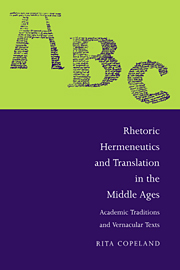Book contents
- Frontmatter
- Contents
- Acknowledgments
- List of abbreviations
- Introduction
- 1 Roman theories of translation: the fusion of grammar and rhetoric
- 2 From antiquity to the Middle Ages I: the place of translation and the value of hermeneutics
- 3 The rhetorical character of academic commentary
- 4 Translation and interlingual commentary: Notker of St. Gall and the Ovide moralisé
- 5 Translation and intralingual reception: French and English traditions of Boethius' Consolatio
- 6 From antiquity to the Middle Ages II: rhetorical invention as hermeneutical performance
- 7 Translation as rhetorical invention: Chaucer and Gower
- Afterword
- Notes
- Bibliography
- 1 Index of names and titles
- 2 General index
4 - Translation and interlingual commentary: Notker of St. Gall and the Ovide moralisé
Published online by Cambridge University Press: 03 December 2009
- Frontmatter
- Contents
- Acknowledgments
- List of abbreviations
- Introduction
- 1 Roman theories of translation: the fusion of grammar and rhetoric
- 2 From antiquity to the Middle Ages I: the place of translation and the value of hermeneutics
- 3 The rhetorical character of academic commentary
- 4 Translation and interlingual commentary: Notker of St. Gall and the Ovide moralisé
- 5 Translation and intralingual reception: French and English traditions of Boethius' Consolatio
- 6 From antiquity to the Middle Ages II: rhetorical invention as hermeneutical performance
- 7 Translation as rhetorical invention: Chaucer and Gower
- Afterword
- Notes
- Bibliography
- 1 Index of names and titles
- 2 General index
Summary
In the medieval commentary tradition, enarratio assumes a rhetorical power of discursive production. It is not mere repetition and reproduction. Rather, it contests and remakes the primary text; it can take on a kind of originary force of its own, becoming a text to be appropriated by later exegetes, to be grafted on to the primary text, and thus to change the conditions of reception for that text. The most characteristic form of this rhetorical or productive action on the text is paraphrase: exegetical paraphrase consumes or envelops the text and can remake the text on many levels, from style to structure to conceptual orientation.
This defining characteristic of Latin hermeneutical practice carries over into the emergent tradition of vernacular commentary. Vernacular textual exegesis builds upon the model supplied by learned Latin precedent. But in vernacular commentary of the Latin auctores, the process of textual paraphrase is also an act of interlingual translation. Thus in some of its most important forms from its earliest history to its later development, vernacular translation maintains strong affinities with established exegetical practice. The association between Latin and vernacular exegesis is very close, and this association has profound implications for our understanding of vernacular translation from the Latin auctores. But before we turn to a consideration of vernacular texts, it will be helpful to offer some preliminary observations on the historical relationship between hermeneutics and translation, and to provide a theoretical model for classifying the kinds of translations to be treated here and in later chapters.
- Type
- Chapter
- Information
- Rhetoric, Hermeneutics, and Translation in the Middle AgesAcademic Traditions and Vernacular Texts, pp. 87 - 126Publisher: Cambridge University PressPrint publication year: 1991



